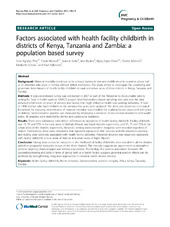| dc.contributor.author | Phiri, Selia Ng’anjo | en_US |
| dc.contributor.author | Kiserud, Torvid | en_US |
| dc.contributor.author | Kvåle, Gunnar | en_US |
| dc.contributor.author | Byskov, Jens | en_US |
| dc.contributor.author | Evjen-Olsen, Bjørg | en_US |
| dc.contributor.author | Michelo, Charles Cheembo | en_US |
| dc.contributor.author | Echoka, Elizabeth | en_US |
| dc.contributor.author | Fylkesnes, Knut | en_US |
| dc.date.accessioned | 2014-09-12T12:12:50Z | |
| dc.date.available | 2014-09-12T12:12:50Z | |
| dc.date.issued | 2014-07-04 | eng |
| dc.identifier.issn | 1471-2393 | |
| dc.identifier.uri | https://hdl.handle.net/1956/8460 | |
| dc.description.abstract | Background: Maternal mortality continues to be a heavy burden in low and middle income countries where half of all deliveries take place in homes without skilled attendance. The study aimed to investigate the underlying and proximate determinants of health facility childbirth in rural and urban areas of three districts in Kenya, Tanzania and Zambia. Methods: A population-based survey was conducted in 2007 as part of the ‘REsponse to ACcountable priority setting for Trust in health systems’ (REACT) project. Stratified random cluster sampling was used and the data included information on place of delivery and factors that might influence health care seeking behaviour. A total of 1800 women who had childbirth in the previous five years were analysed. The distal and proximate conceptual framework for analysing determinants of maternal mortality was modified for studying factors associated with place of delivery. Socioeconomic position was measured by employing a construct of educational attainment and wealth index. All analyses were stratified by district and urban–rural residence. Results: There were substantial inter-district differences in proportion of health facility childbirth. Facility childbirth was 15, 70 and 37% in the rural areas of Malindi, Mbarali and Kapiri Mposhi respectively, and 57, 75 and 77% in the urban areas of the districts respectively. However, striking socio-economic inequities were revealed regardless of district. Furthermore, there were indications that repeated exposure to ANC services and HIV related counselling and testing were positively associated with health facility deliveries. Perceived distance was negatively associated with facility childbirth in rural areas of Malindi and urban areas of Kapiri Mposhi. Conclusion: Strong socio-economic inequities in the likelihood of facility childbirths were revealed in all the districts added to geographic inequities in two of the three districts. This strongly suggests an urgent need to strengthen services targeting disadvantaged and remote populations. The finding of a positive association between HIV counselling/testing and odds in favor of giving birth at a health facility suggests potential positive effects can be achieved by strengthening integrated approaches in maternal health service delivery. | en_US |
| dc.language.iso | eng | eng |
| dc.publisher | BioMed Central | eng |
| dc.rights | Attribution CC BY | eng |
| dc.rights.uri | http://creativecommons.org/licenses/by/2.0 | eng |
| dc.subject | Health facility childbirth | eng |
| dc.subject | Home deliveries | eng |
| dc.subject | Socioeconomic position | eng |
| dc.subject | Inequity | eng |
| dc.subject | Africa | eng |
| dc.subject | Kenya | eng |
| dc.subject | Tanzania | eng |
| dc.subject | Zambia | eng |
| dc.title | Factors associated with health facility childbirth in districts of Kenya, Tanzania and Zambia: a population based survey | en_US |
| dc.type | Peer reviewed | |
| dc.type | Journal article | |
| dc.date.updated | 2014-08-27T11:30:06Z | |
| dc.description.version | publishedVersion | en_US |
| dc.rights.holder | Selia Ng’anjo Phiri et al.; licensee BioMed Central Ltd. | |
| dc.rights.holder | Copyright 2014 Ng’anjo Phiri et al.; licensee BioMed Central Ltd. | |
| dc.source.articlenumber | 219 | |
| dc.identifier.doi | https://doi.org/10.1186/1471-2393-14-219 | |
| dc.identifier.cristin | 1153704 | |
| dc.source.journal | BMC Pregnancy and Childbirth | |
| dc.source.40 | 14 | |

